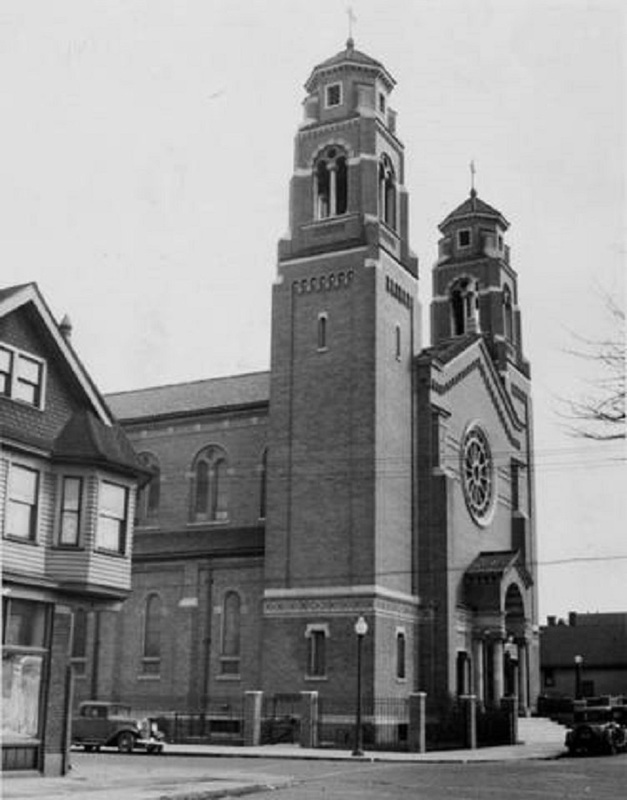Zak Funeral Home

Funeral homes are necessary to every functioning community, but they are generally not the sexiest and most popular businesses in town. Successful ones, however, provide more than just rudimentary mortuary services to their neighbors, and are staunch and dependable cornerstones locals know they can rely on in times of need. The St. Clair-Superior neighborhood has been a close-knit, self-contained community ever since it began to develop in the mid-19th century. Central European immigrants initially built this area of Cleveland in the image of the small Germanic towns they left behind for the enticing opportunities and freedoms America promised. They opened businesses offering jobs, goods and services of every description that supplied the growing neighborhood with everything it needed. There has been a funeral home stationed at 6016 St Clair Avenue since 1871, which has been operated by just two families during that entire period. To be a successful entity for that length of time takes more than just hanging a shingle and setting up shop. Because of their devotion to, and belief in their community, the Ziehm, and following them, the Zakrajsek families have operated an integral and well-rooted funeral home that has faithfully served the neighborhood for nearly 150 years.
The funeral parlor on St Clair between Norwood Avenue and East 60th Street has long sat at the epicenter of Cleveland’s Slovenian community, but it was first owned by Frederick Ziehm, a German immigrant that would head a large, prosperous and industrious family. Cabinetry and the funeral business seemed to go hand in hand in the 19th century, and Frederick opened the business in 1871 as a cabinetmaker/undertaker. Eventually an efficient horse-drawn ambulance service and livery was operated from the business as well, and on July 16, 1907, a record-breaking ambulance run was made to Lakewood and back to Glenville Hospital to aid a worker who had fallen 50 feet from a scaffold—covering the 16 miles in a maniacal 76 minutes. The business continually expanded in the early 20th century as Frederick’s sons opened up similar shops of their own. All seemed to be capable, well-respected and confident men. One such son, William, was working out of the shop on St Clair in late January of 1901. As he left a nearby saloon, he was accosted by a ‘highwayman’ who pressed a gun to his head. Ziehm calmly shoved the gun aside and proceeded to beat the man bloody saying, “If I had hit the man twice more I would have had to embalm him.” Instead, he judged the beating punishment enough and sent the man home to his family without bothering the police.
In 1890, as the Ziehms established themselves on St Clair, Frank Zakrajsek, another carpenter/undertaker, opened a similar shop only a short walk away at 1105 Norwood Avenue. Although the neighborhood residents from a range of Central European backgrounds seemed to have mixed well in the area, there were inevitable misunderstandings, and there is even evidence of possible competition between the two strong-willed, neighboring undertakers. A battle over the body of a young Slovenian painter, Frank Alic, took place in the basement of Zakrajsek’s establishment on November 11, 1907. The young painter had no relatives in America and was suspiciously well-off when he passed away. Being Slovenian and a member of St Vitus church, which particularly catered to area Slovenes, it was not unusual that Frank Zakrajsek would rush over and bring the man’s body to his funeral home. Apparently, arrangements had already been made with Ziehm, however, and an overly-aggressive deputy burst into Zakrajsek’s shop and proceeded to crack heads with “chairs and casket lids” until he was able to throw the unfortunate Alic’s body over his shoulder and carry him out to the waiting Ziehm ambulance.
Things have calmed down considerably these days. In 1932, the current St. Vitus Church was built on East 61st Street and Glass Avenue (now Lausche), and, despite struggling through the hard-times of depression era America, the Zakrajseks decided it would be wise to move the short distance right along with it, and bought the Ziehm property that sat on the opposite side of the block from it. They rebuilt the structure in 1937 creating the current red-brick Colonial Revival-style building with the four sets of distinctive white double-pillars that has been a familiar landmark in the area ever since. As the neighborhood evolved and became ever more Americanized, the unwieldly Slovenian name was shortened to Zak in the 1950s to make it easier on non-Slovenian tongues. The Zak Funeral Home has served the community loyally for four generations through all of the ups and downs that the neighborhood has experienced. This service was especially evident after the East Ohio Gas explosion in 1944, when desperate families who lost everything in the disaster, suddenly needed funerals for the hundreds of victims. Funerals are always going to be a sad business, but perhaps the saddest occurred when George Voinovich, at the time running for what would soon be his first term as Cleveland mayor, lost his 9 year old daughter Molly when she was hit and killed by a van while walking back to school in 1979. The line of mourners stretched nearly to the Hofbrau House on the corner of East 55th Street for the service.
The St. Clair-Superior neighborhood has been evolving for well-over a century and a funeral home has been a crucial support for this ever-changing community all along. What began as a self-contained neighborhood made up primarily of Slovenian and German immigrants who made their way in their new country with hard work and help from their neighbors, has become an even more diverse area. The Zak Funeral Home prides itself on being a responsible and committed member of the community and plans to continue supplying strong and dependable support for this proud and rebuilding neighborhood.
Audio
Images












